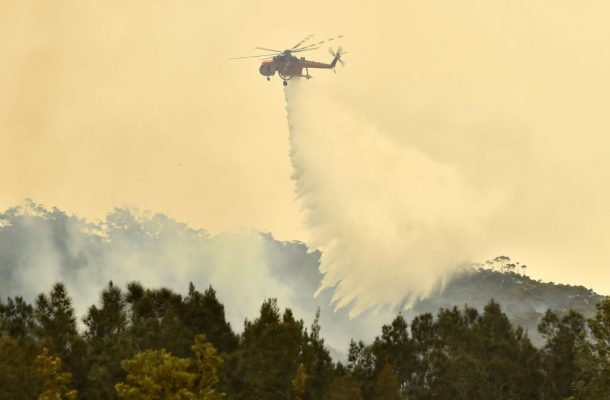Building research capacity for a disaster-resilient Australia

Australia’s threat landscape has changed dramatically over the past 12 months—starting with last summer’s cataclysmic bushfires, followed by the appearance of Covid-19 and its cascading impacts on society and the economy, and now the expected arrival of La Niña weather patterns bringing increased rainfall and the onset of an early monsoon season in the tropics as well as increased cyclonic activity.
While current conditions are very different to those leading up to last year’s crises, state, territory and federal agencies and local governments have sustained their efforts over the winter period to mitigate risk factors critical to the summer ahead. A viable question, however, is what does Australia need to emphasise now to position itself to better cope with the conditions of our near future?
Some steps towards answering that question have been taken by the initiation of the Royal Commission into National Natural Disaster Arrangements. The royal commission published a set of interim observations on 31 August providing some insight into the direction of its thinking.
These observations cover a selection of issues ranging from cultural burning practices and existing national natural disaster arrangements (including constitutional issues) to community health impacts and the role of local government.
A few days later, on 4 September, counsel assisting the royal commission released a set of draft propositions covering aspects of the terms of reference for the commission, informed by submissions and evidence supplied since hearings began in May this year.
While each document addresses several important elements, both focus on supporting increased research to enhance Australia’s resilience to natural hazards and reduce disaster risk, aligned to national research priorities.
A key driver of that research capacity is the new national disaster research centre, announced by the government on 23 July with a commitment of $88.1 million over 10 years.
The centre will be ‘co-funded by partners from across Australia, including state and territory governments and emergency service agencies, universities and industry partners’. It is expected to be collaborative on a national scale.
Collaboration within Australia’s higher education system on disaster resilience outcomes is obviously of benefit to all, but a question of some interest is how to structure a collective effort. Here are two ideas to support this important outcome.
The first focuses on intra-university teaching and research collaboration. In August 2011, the Innovative Research Universities (IRU) group published a brochure titled ‘Disaster resilience: preparing, responding and adapting’.
It outlined a variety of teaching areas and research strengths among its members that showcased different yet complementary expertise across a range of disaster management and resilience knowledge areas.
A logical extension of the intent of the IRU group could have been the establishment of a consortium to combine the teaching and research expertise of the member universities.
Such a step could have led to unique learning opportunities by allowing students to combine units from different institutions, while cross-registered, and receive full credit for towards their final qualification.
Access to these types of opportunities would also allow undergraduate and postgraduate students to complete modularised units of study that match their professional development needs: some in their home university and others with partner institutions. In the case of disaster management agencies, in-service students could have combined units of study that meet institution-specific needs.
Further collaboration among consortium partners for joint supervision of higher degree research students would have required little additional effort given the processes already used in the Cotutelle model common in many Australian universities for linking with international universities on joint supervision of local PhD candidates.
Alliances like the IRU group’s are not uncommon among Australian universities. The NUW Alliance for example, comprising the University of Newcastle, the University of New South Wales and the University of Wollongong, cooperates on shared strategic priorities in research and teaching that each institution might not be able to pursue on its own.
The second idea entails establishing or reinvigorating applied research centres or institutes to examine natural hazards and disaster resilience within universities and act as enablers of innovative thinking in private-sector and public-sector institutions active in disaster management.
Australian universities have a long history of supporting research groups in these areas. Notable among those currently active are the Torrens Resilience Institute at Flinders University, the Australian National University’s Disaster Risk Science Institute, the Centre for Disaster Management and Public Safety at the University of Melbourne, and Monash University’s Disaster Resilience Initiative.
They, like those that came before, play important facilitation roles between academia’s ‘hallowed halls’ and the real world.
Creating wider opportunities to educate new cohorts of disaster management professionals and to generate new and easily utilised knowledge at both regional and national levels is critical.
Australia can’t afford to be in a position in which new entrants to the professions active in emergency and disaster management and resilience building must wait to learn real-world skills and develop insight on the job.
Neither can we afford to leave emergency and disaster management agencies reliant on underdeveloped internal research capabilities, especially as research and development may not be core business.
The royal commission’s advice on our national research needs can be supported through the creation (where needed) of university-based research and collaboration centres operating in close coordination with state-based disaster management agencies.
In addition, we need to encourage the development of a consortium of universities collaborating on teaching core and evolving skills for enhancing disaster resilience.
Such programs should be offered at both undergraduate and post-graduate levels, using the established Cotutelle model (where feasible) for domestic co-supervision of higher degree research candidates across consortium members.
The intellectual capability for these innovations exists already in our universities. We need to apply our productive higher education sector to support the new all-hazards, all-threats crisis-readiness and response repertoire required for the near future and beyond.
Australia needs a networked consortium of teaching universities—including regional research centres—supporting our emergency and disaster management needs across the broad spectrum of existential threats we face.
This article was published by The Strategist.
Dr Paul Barnes is a Research Fellow specialising in urbanisation and disaster resilience in the Institute of Global Development at the University of New South Wales. He previously established the Risk & Resilience Program at the Australian Strategic Policy Institute.















